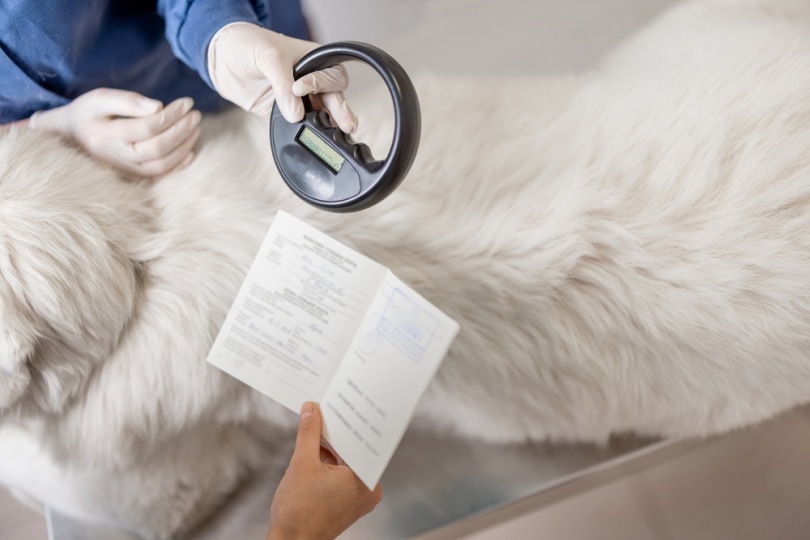
At this point, we’ve all heard about people having their pets microchipped. Maybe you’re on the fence about getting your dog microchipped, though. Are microchips safe? Are they beneficial? Will a microchip actually help get your dog home if they get lost? Is microchipping a painful procedure?
All of these questions are probably going through your mind if you’re trying to weigh the pros and cons of having your dog microchipped. Your vet is the best resource for questions regarding microchipping, but here are some of the pros and cons you should know.
The Pros of Getting Your Dog Microchipped
1. Get Your Lost Dog Home
The primary benefit of having your dog microchipped is that a microchip will help get your dog back home to you if they go missing. Even the most responsible pet owners still run the risk of a dog getting loose, whether they break free from the backyard, take an opportunity out an open door, break their leash on a walk, or jump out of the car and bolt during an outing. There are a lot of ways that your dog can go missing, but a microchip will help your dog get back to you.
Microchips store your information, so if someone finds your dog and scans them for a microchip, the ID number associated with your dog’s microchip will be connected to the information you submitted to the microchip company. They will be able to get in contact with you, as long as your information is up to date, and help get your dog home.

2. Prove Ownership
In some unfortunate circumstances, ownership of a dog may come into question. This could occur if your dog got out and was found by someone else or picked up by animal control, or it can even happen in domestic situations. If the ownership of a dog comes into question, a microchip can help determine who the owner of the dog actually is.
In some areas, there is a legal precedent for a microchip proving ownership, but this can vary by location, so it’s best to familiarize yourself with the laws regarding pet ownership in your area.
If your dog is taken in by a rescue, shelter, or individual and there is a question of ownership, a microchip can help you prove your rightful ownership of the dog.
3. Good for Life
The best thing about a microchip is that they are good for life. It isn’t something that is operated via a battery, so it won’t “die” or require recharging. Once in place, your dog’s microchip will be with them for their entire life. The only thing you’ll need to be sure of is that you keep the information associated with the microchip updated, which means that if you move or change phone numbers, you’ll need to update it.
Microchips are typically put in between the shoulder blades, but in some cases, they will migrate elsewhere in the body. If you know your dog has a microchip and it isn’t showing up on a scan between the shoulder blades, make sure to ask that your dog is scanned all over to determine if the microchip has shifted or is no longer in place.
In rare instances, microchips can fall out shortly after implantation if they are not put in place correctly, so always ask to have your dog scanned for the chip placement after implantation.

4. Minimally Invasive
There is no anesthesia required to place a microchip. It’s a minimally invasive procedure that can be performed when your dog is asleep for another procedure like a spay/neuter procedure or dental cleaning, but microchips can also be implanted when your dog is awake.
Since the procedure is minimally invasive, there is no downtime after implantation, so your dog will be ready for all of their normal activities after it’s put in place, assuming they didn’t have a sedative procedure at the same time.
5. Minimally Painful
Your dog can have a microchip implanted with very little pain. Some dogs may not even react when the microchip is put in place, while others may give a quick yelp or try to jerk away from the needle.
The needle used for microchip implantation isn’t small, so there is a potential for some discomfort, but the pain is minimal, and many dogs don’t seem to even feel it at all. Some vets may opt to use a local injection to numb the area where the microchip will be implanted, but sometimes these injections can be just as painful as the procedure itself, so most vets don’t opt for this.
If you have concerns about the potential pain level for your dog, you can ask the vet to implant the microchip while your dog is asleep for another procedure. Microchip implantation is not contraindicated during the majority of procedures.

6. Protects Your Information
If you have concerns about your information being out in the open for all to see on your dog’s collar or tag, a microchip is a good way to help protect your personal information. You can determine exactly what information you want to be associated with your dog’s microchip, so you can put as much or as little information in the database as you prefer.
If someone finds your dog and contacts the microchip company, many companies will contact you directly instead of giving your information out to the caller. This is not standard across all companies, though, so make sure to find out before you go with a specific company if having your information shared with people who find your dog is a concern.
What Are the Cons of Microchipping?
The primary thing that people misunderstand about microchips is that they are not GPS products. A microchip contains an ID number that is associated with the information that you submit to the microchip company, so your dog must be found and scanned for their microchip. You won’t be able to track your dog with a microchip if they get loose. If you’re looking for GPS capabilities, you’ll need to look into GPS collars and tags.
There is also a small risk of inflammation, bleeding, and minor infection with microchip implantation. Even though the procedure is minimally invasive and minimally painful, it isn’t without any risks. Most vets strongly feel that the benefits of microchipping far outweigh the risks, though, especially since the risks are generally extremely mild and short-lived.

Having your dog microchipped does require a commitment on your part to keep your information updated in the microchip database. If your phone number or address changes and isn’t updated, then it may be difficult or even impossible to find a way to get your dog back to you.
Most microchip companies offer memberships, but these memberships are typically associated with extra benefits, like additional help if your dog goes missing. The majority of companies don’t require you to keep a membership up to date in order to maintain your information or help get your dog home to you, but it’s a good idea to check the membership benefits and policies of the company you choose or that your vet uses.
Conclusion
The risks and cons associated with microchipping are minimal, while the benefits are great. A microchip is a minimally invasive, low-risk way to ensure your dog gets back home to you if they go missing.
No matter how responsible a pet owner you are, there is always a risk of your dog going missing. Sometimes, this is entirely out of your control. Microchipping is a safe and effective way to help your dog find their way back to you and to prove ownership.
Featured Image Credit: LightField Studios, Shutterstock






